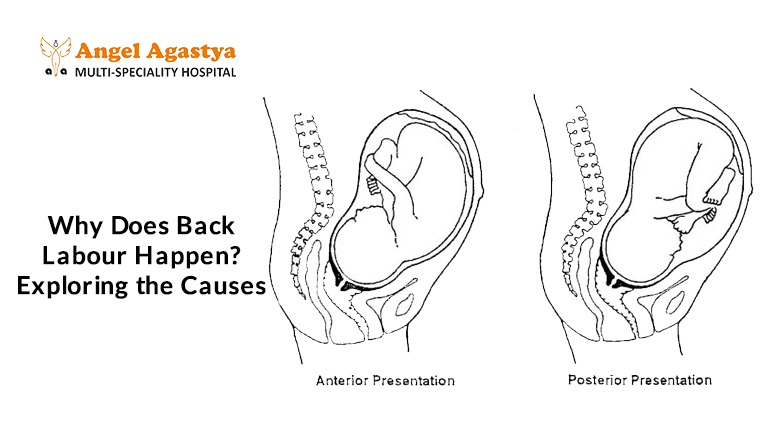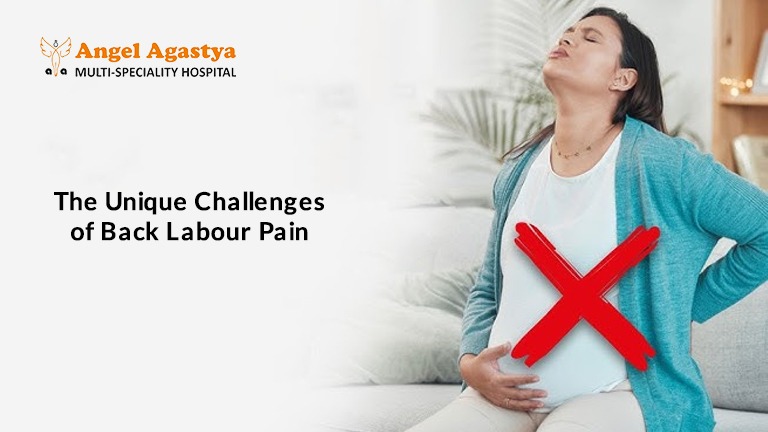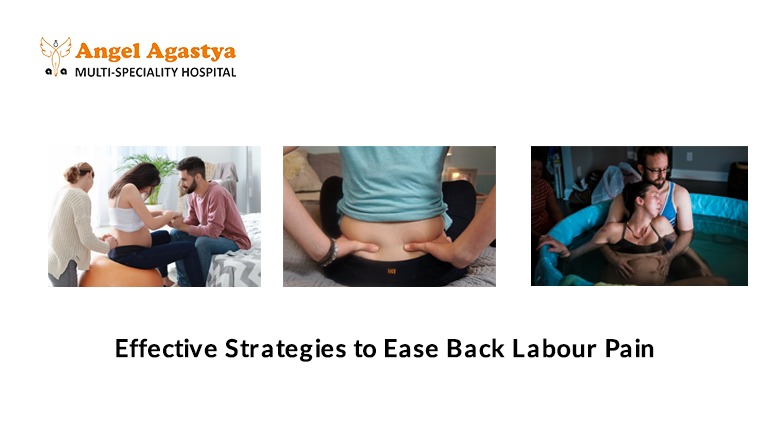The Relentless Ache: Understanding Back Labour and Effective Ways to Find Relief
Labour pains aren’t always what we imagine sometimes, they show up as a constant, exhausting ache in the lower back. This is known as Back Labour and it’s more common than you might think. If you’re pregnant or preparing for delivery, understanding this unique form of pain and how to manage it can make a world of difference to your birthing experience.

Introduction
The journey of childbirth in India is often imagined with a mixture of anticipation, strength and tradition. Most people think of Labour as intense cramps in the abdomen that waves of pain that come and go. But for some mothers-to-be, the real challenge lies not in the belly, but in the lower back. This is known as Back Labour a deeper, more persistent pain that grips the lumbar region like a constant ache.
If you’re preparing for childbirth or supporting someone who is, understanding Back Labour is key. This blog aims to explain why Back Labour happens and how to ease its discomfort with time-tested remedies and modern methods.
What Exactly is Back Labour?
Back Labour is a condition where labour pain is primarily felt in the lower back, rather than just the abdomen. The pain is often constant, unlike regular contractions that come and go. Many Indian women describe it as a deep, nagging pressure that extends from the lower spine to the thighs, making it difficult to rest or focus.

While traditional abdominal cramps still occur, Back Labour stands out for its persistence and intensity. It can happen during any phase of Labour that may be early, active or transition. It adds an extra layer of challenge, especially for first-time mothers.
Why Does Back Labour Happen? Exploring the Causes
Many times, when labour becomes unusually difficult, elders often say, “the baby is pressing on the back.” Interestingly, this age-old observation holds medical truth. Let’s understand the real reasons behind Back Labour, a form of labour pain that can feel more intense and persistent than usual.

1. Posterior Fetal Position (Occiput Posterior) – The Most Common Cause
This is the leading reason behind back labour. In this position, the baby is head-down but facing the mother’s abdomen instead of her spine. As a result, the hardest part of the baby’s skull presses directly against the sacrum (the lower part of the spine), causing constant and intense back pain during contractions. While some babies turn into a better (anterior) position during labour, others may remain posterior, leading to prolonged and painful back labour.
2. Asynclitic Presentation – When the Head Tilts Awkwardly
Here, the baby’s head enters the birth canal at an angle instead of being straight. One side of the head pushes more than the other, creating uneven pressure on the pelvic bones. This awkward entry increases discomfort, particularly in the lower back and may slow down labour progression.
3. Cephalopelvic Disproportion (CPD) – A Size Mismatch
In some cases, the baby’s head may be slightly larger than the mother’s pelvic opening. This mismatch makes it harder for the baby to descend smoothly, especially if the baby is also in a posterior position. The resulting strain on the lower back muscles and pelvic bones can lead to severe back labour pain and longer labour.
4. Tight Abdominal Muscles – Restricted Movement Inside the Womb
Lack of physical activity, sedentary lifestyle or tension in the abdominal muscles can limit the baby’s ability to rotate into the optimal position. This makes it more likely for the baby to stay in a posterior position. Regular prenatal stretching or simple prenatal yoga (as practiced in many Indian traditions like Garbha Sanskar) can encourage better alignment and reduce the chances of back labour.
5. Pelvic Shape – A Natural Variation That Matters
Every woman’s pelvis has a unique shape. Certain pelvic types are more likely to encourage a baby to settle in a posterior position. While pelvic structure can’t be changed, being aware of this factor helps expectant mothers prepare mentally and physically and allows care providers to suggest helpful positioning techniques during labour.
The Unique Challenges of Back Labour Pain
Back labour is very different from the usual labour pain. In normal contractions, the pain comes in waves – it builds up, reaches a peak, and then eases. But in back labour, the pain often feels constant, like a deep, dull ache that never fully goes away between contractions.

Many Indian mothers describe it as a stronger version of severe period pain, or like a heavy pressure pulling on the lower back. Some even say it feels like the back is being stretched or torn from inside.
This type of pain can be very tiring, both physically and emotionally. The constant ache doesn’t give the mother much time to rest between contractions, which can lead to fatigue, frustration and even fear. This may also make it harder for labour to progress smoothly.
In some Indian households, especially in rural areas or joint family setups, mothers may not always have one-on-one support or access to pain relief methods like massage, hot compress, or water therapy. Without proper help and awareness, managing back labour becomes even more difficult.
That’s why knowing about back labour in advance and having a birth partner, doula, or support system can make a big difference.
Effective Strategies to Ease Back Labour Pain
Here are tried-and-tested methods, many of which are rooted in both modern science and ancient Indian wisdom:

- Counter-Pressure: Applying firm pressure to the lower back using fists, tennis balls or even wooden rollers (used traditionally in Indian massages) can help. Your partner or a midwife can assist with this during contractions.
- Pelvic Tilts and Rocking: Gentle movements done on all fours or using a birth ball (now available in Indian maternity centers) can help reposition the baby and reduce Back Labour.
- Sacral Massage: Massaging the lower back with warm sesame or coconut oil, which is common in Indian households, can relax the back muscles and ease the pain.
- Hot and Cold Therapy: Warm compresses or cold packs on the lower back offer significant relief. You can use a warm towel soaked in ajwain (carom seed) water, a remedy used by Indian grandmothers for aches.
- Water Therapy: A warm bath or shower helps relax back muscles. Many hospitals in urban India now offer water birthing or hydrotherapy options.
- Changing Positions Frequently: Keep moving, lie on your left, kneel, squat with support or stand and sway. These traditional birthing movements are encouraged in Indian midwifery practices too.
- Breathing Techniques: Practice slow, deep breathing, much like pranayama. Controlled breathing not only distracts from pain but keeps you calm and focused.
- Vocalization: Moaning or humming during contractions, often seen in traditional Indian births can help release tension and soothe the nervous system.
- Birth Partner or Doula Support: Emotional and physical support from a husband, mother or doula during Back Labour can make a world of difference. Their reassurance helps in reducing the fear and discomfort.
- Epidural Anesthesia: If the pain becomes unmanageable, an epidural is a safe option. Many Indian hospitals now offer this pain relief under expert guidance.
When to Seek Additional Help
If your Back Labour becomes too intense or you feel your Labour isn’t progressing, speak up. In India, where modesty or cultural hesitation may prevent women from voicing discomfort, it’s essential to remember that your pain is valid. Don’t hesitate to request assistance or interventions. Doctors and midwives can assess the baby’s position and offer appropriate solutions.
Conclusion
Back Labour can be a demanding part of the birthing journey, but with knowledge, preparation and the right support, you can manage it with strength and confidence. From warm compresses and counter-pressure to breathing deeply and staying mobile, there are many ways to cope. Talk to your doctor, trust your instincts and remember—you are not alone. Many Indian mothers before you have walked this path with courage and you can too.
Whether you’re giving birth in a city hospital, a small-town clinic or at home with your family around you—Back Labour can be managed. May your delivery be safe, empowered and filled with love.
FAQs on Back Labour
What is Back Labour and how is it different from normal Labour pain?
Back Labour refers to intense pain primarily in the lower back during Labour, as opposed to the usual abdominal cramps. It feels like a deep, constant ache and is often more persistent and exhausting than typical Labour contractions.
What causes Back Labour in pregnant women?
The most common reason is the baby being in a posterior position (facing the mother’s belly instead of the spine). Other causes include tilted baby’s head (asynclitic position), tight abdominal muscles, pelvic shape or cephalopelvic disproportion.
Is Back Labour common among Indian women?
Yes, Back Labour can occur in women worldwide, including India. It is often underreported due to lack of awareness or cultural hesitation to discuss Labour pain openly.
How can I relieve Back Labour pain at home or in the hospital?
Some effective methods include:
- Applying counter-pressure to the lower back
- Gentle pelvic tilts and rocking on a birth ball
- Warm compress or ajwain water towel
- Breathing techniques (like pranayama)
- Changing positions often
Can Indian traditional remedies help with Back Labour?
Yes. Warm oil massages with sesame or coconut oil, applying ajwain poultices and using heat therapy are traditional Indian methods that can provide relief during Back Labour.
Does Back Labour mean something is wrong with the baby or the delivery?
Not necessarily. Back Labour often occurs due to fetal position and doesn’t mean anything is wrong. However, if the pain is severe or Labour is not progressing, consult your doctor immediately.
Can Back Labour affect a normal vaginal delivery?
In many cases, women with Back Labour can still have a normal vaginal delivery. If the baby doesn’t rotate to a better position, doctors may recommend assisted delivery or cesarean in some situations.
Can I prevent Back Labour during pregnancy?
You can reduce the chances by:
- Practicing prenatal yoga
- Avoiding reclining too much in the last trimester
- Sleeping on your left side
- Doing gentle pelvic exercises regularly
Can epidurals help with Back Labour pain?
Yes, epidural anesthesia is highly effective for relieving severe Back Labour pain. Discuss with your doctor beforehand to understand the pros and cons based on your health.
Should I inform my doctor if I suspect Back Labour?
Absolutely. Always communicate any unusual or persistent back pain during Labour. Our medical team can assess and provide the right support to manage Back Labour effectively.

